Evaluating the Essential Factors Building the Value-Based Healthcare Model
Nov 24, 2021
Table of Contents
Value-based healthcare is a healthcare delivery model or a process in which the providers, including hospitals and physicians, are paid based on patient health outcomes. It is one of the alternative models that offer value and also has the potential to transform and improve healthcare delivery in each and every region. It is becoming an important global asset because it is combining different facets of treatment so that a patient can take advantage of all required medical resources available to them through effective diagnosis and therapy. The ultimate goal is to allow patients to aid themselves and access the best treatment choices available.
There are considered some standard value-based care agreements, under which the providers are rewarded for helping patients in improving their health, reducing the effects and incidence of chronic disease, and also assisting them to lead healthier lives in an evidence-based way. Value-based care certainly is a very different approach from a fee-for-service or capitated approach. In the capitation approach, providers are paid based on the number of healthcare services they deliver. Whereas the “value” in Value-based Healthcare is obtained from measuring health outcomes against the cost of delivering the outcomes. The shift from a fee-for-service healthcare delivery model to a value-based care model has significantly changed the way healthcare is delivered and reimbursed.
Downloads
Click Here To Get the Article in PDF
Recent Articles
- Baird Medical’s Microwave Ablation System; BrainSpec’s AI-Backed Solution for Non-Invasive Brain ...
- From Paper to Pixels: The Advantages and Challenges of Electronic Health Record
- Digital Twin Technology – Assessing the Growing Role and Its Evolving Applications in Healt...
- Top healthcare innovations changing the healthcare dynamics
- The Business Cocktail
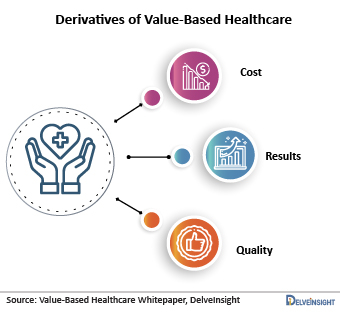
Value-based healthcare is a healthcare delivery framework that incentivizes healthcare providers to focus on the quality of services rendered, as opposed to the quantity. Under a Value-based healthcare model, healthcare providers (including hospitals and physicians) are encouraged and also compensated on the basis of patient health outcomes. Clinicians who actively participate in the value-based care agreements are then rewarded for promoting healthy patient outcomes, helping their patients live healthier lives through evidence-based medicine, and also reducing the chronic disease burden. Value-based healthcare programs are vital to a larger quality strategy to reform how healthcare is delivered and paid for. According to DelveInsight analysis, Value-based healthcare supports the triple-aim of providing better care for individuals, better health for populations, at a lower cost. Also nowadays the triple aim is being expanded to the quadruple aim, which includes physician and health care professional well-being.
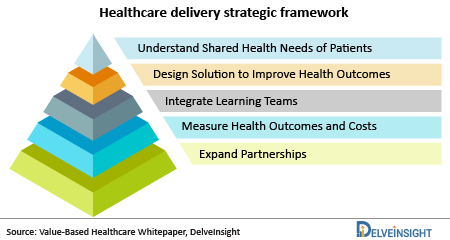
Why is Value-Based Healthcare Important?
Value-based healthcare is the necessity of the hour due to the fact that the traditional fee-for-service model of healthcare delivery needs revision/replacement. For ages now, the emphasis was pivoted around how many services a healthcare provider delivered versus the focus on the quality of care being delivered. Value-based healthcare specifically aims at value over the volume of care.
Improving a patient’s health outcomes relative to the cost of care is an aspiration embraced by stakeholders across the health care system, including patients, providers, health plans, employers, and government organizations. By focusing on the outcomes that matter most to patients, value aligns care with how patients experience their health. Health outcomes can be described in terms of capability, comfort, and calm.
- Capability is the ability of patients to do the things that define them as individuals and enable them to be themselves. It is often tracked with functional measures.
- Comfort is relief from physical and emotional suffering. In addition to reducing pain, improving patients’ comfort requires addressing the distress and anxiety that frequently accompany or exacerbate illness.
- Calm is the ability to live normally while getting care. It encompasses freedom from the chaos that patients often experience in the healthcare delivery system, and it is especially important for people with chronic and long-term conditions.
Value-based healthcare improves outcomes in all 3 of these dimensions and creates a better experience for patients. Moreover, capability, comfort, and calm describe outcomes that result from the efficacy and empathy of health care, rather than its hospitality.

Better outcomes also reduce spending and decrease the need for ongoing care. By improving patients’ health outcomes, value-based health care reduces the compounding complexity and disease progression that drive the need for more care. A patient whose diabetes does not progress to kidney failure, blindness, and neuropathy is, over time, dramatically less expensive to care for than a patient whose condition continually worsens. By organizing teams to care for individuals with similar needs, a value-based approach enables expertise and efficiency, rather than rationing, to drive costs down. This puts decisions about how to deliver care in the hands of the clinical team, rather than those of an insurance administrator, supporting the professionalism of clinicians and the power of clinician-patient relationships to deliver effective and appropriate care.
What Are the Benefits of Value-Based Healthcare Delivery?
The benefits of a Value-Based Healthcare system extend to patients, providers, suppliers, payers, and also the society as a whole.
Patients spend less money to achieve better health outcomes
In Value-based healthcare systems, healthcare providers concentrate more on providing preventative care while managing chronic diseases or conditions which can be very costly and time-consuming for patients suffering from cancer, diabetes, hypertension, COPD, obesity, etc. Value-based healthcare models solely focus on assisting patients to recover from illnesses and injuries more quickly and also to avoid chronic disease occurrence in the first place only. In conclusion, doctor’s visits, medical tests, and other procedures are reduced and expenses on prescription medication as both near-term and long-term health improve.
Providers achieve efficiencies and increased patient satisfaction
Value-based healthcare compels clinical specialists to achieve financial targets as well as improvement in patient satisfaction and experience as well. This is done due to the factual practice of patients who experience excellent healthcare return back to the services provided and also recommend them further. Healthcare providers may at times need to spend more time on new, prevention-based patient services, they will also spend lesser time on chronic disease management. The focus is on value rather than volume which increases quality and patient engagement measures. Some factors to improve patient satisfaction includes – improving communication with patients, respecting patients, making the practice engaging, optimizing the appointment process in an easy way, simplifying the billing process, using the best medical billing software, and many more.
Stronger cost control and reduce risk for payers
The Value-based healthcare system benefits patients, healthcare providers, and also payers. Value-based payment also allows payers to increase efficiency by bundling payments that cover the patient’s full care cycle, or for chronic conditions, covering periods of a year or more. Payers can control costs and reduce risk by spreading it across a larger patient population. A healthier population with fewer claims results in less impact on payers’ premium pools and investments.
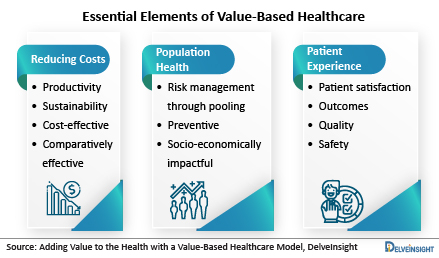
Suppliers align prices with patient outcomes
Suppliers benefit from being able to align their products and services with positive patient outcomes and reduced cost, an important selling proposition as national health expenditures on prescription drugs continue to rise. Many healthcare industry stakeholders are calling for manufacturers to tie the prices of drugs to their actual value to patients, a process that is likely to become easier with the growth of individualized therapies.
Society becomes healthier while reducing overall healthcare spending
It is very simple when fewer people need costly care, total healthcare spending decreases, which has beneficial financial implications for individuals, businesses, and the government. In a Value-based healthcare system, less money is spent helping people manage chronic diseases, costly hospitalizations and medical emergencies.
Improved Care Coordination
In a traditional healthcare model, healthcare providers don’t necessarily have to motivate the workforce to operate with different suppliers in order to provide effective care for their patients. In contrast to this, in a Value-based healthcare model, there are incentives and improved technologies that enable healthcare providers to improve coordinated care. The integration produced by collaborative care creates better outcomes for patients because all of their healthcare providers work together to improve overall health.
| Lower Healthcare Costs | Alignment of prices with patient outcomes | Reduced healthcare spending |
| Higher Patient Satisfaction | Reduced Risks | Better overall health |
| Improved Care Coordination | Efficiency by providers | Value not Volume |
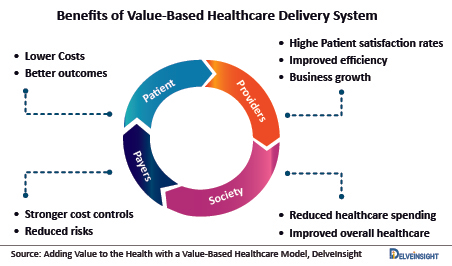
How to Implement Value-Based Healthcare?
A healthcare professional can take several steps in order to begin implementing Value-based healthcare in practice. Provided below are five steps that a healthcare provider takes to prepare the practices for value-based care:
- Identifying the patient population and opportunity
- Design the desired care model
- Partner for successful results
- Drive appropriate utilization of resources
- Quantify impact and continuously improve
Implementing and understanding Value-based healthcare should be done with proper thought and planning. For many physicians, this means striking a balance between fee-for-service and value-based care as their practices navigate traditional revenue cycle management. When implementing value-based care, it is critical to embrace technology and establish partnerships to help make the transition seamless and cost-effective. A good place to start is with a robust IT infrastructure, including an electronic health record system and population health management tools. Telehealth and its arms are certainly growing in Value-based healthcare models. Telehealth has been proven to increase patient satisfaction and improve patient outcomes through continuous contact and connection with their providers. Patients who use telehealth, especially for chronic conditions, see lower rates of hospital readmission, which proves cost-effective almost immediately. Aligning with the idea of Value-based healthcare, patients get more out of their health care plans with telehealth than ever before.
Apart from telehealth, some of the new technologies and practices such as Smart hospitals, Digital therapeutics, artificial intelligence (AI), and subscription-based healthcare models are also making significant advancements in the Value-based healthcare systems. These technologies are expected to deliver better health outcomes with early detection, right diagnosis and also avoiding severe complications. Globally, medical and healthcare costs are rising immensely and it is one of the major factors in the decision-making process. These new technologies and processes, while reducing healthcare delivery costs on one side, focus on maximizing the efficacy, affordable and outcomes to the other side.
Future Impact of Value-Based Healthcare
As the healthcare landscape continues to evolve on a large scale, healthcare providers have started adopting Value-based healthcare models. They may seem like short-term financial hits before longer-term costs decline but the huge transition from fee-for-service to fee-for-value has been embraced as a great method for increasing quality healthcare and lowering healthcare costs. The adoption of Value-based payment healthcare and prospective systems is altering the way physicians and hospitals provide people with care. New value-based programs stress a team-oriented, network approach to patient care management that involves the responsible sharing of patient data so that care is coordinated. Adoption of healthcare technology like electronic health record systems create a computerized system view, so outcomes can be readily measured. Many key companies such as Bright Health, AllyAlign Health, VitalityHealth, AMC Health, Alignment Healthcare, Troy Medicare, Connect Insurance Agency, SentryHealth, Wellframe Solutions, Health Recovery Solutions, LifePod are associated with providing Value-based healthcare delivery framework to the needful people.
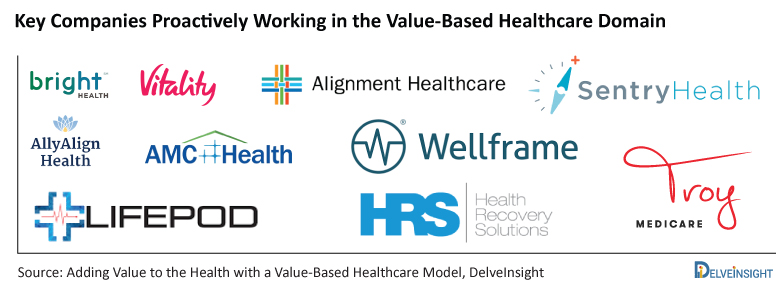
Improving health outcomes as a goal in itself is worthy but cannot be achieved at any cost in a health system with a fixed budget. Managing the use of financial resources is essential in a health service with budgetary pressures, but cost efficiencies can be misplaced. The relationship between health outcomes with resource use, resource allocation and context must be understood to make good decisions. A common language to articulate this relationship is needed if Value-based healthcare is to be embraced. DelveInsight suggests that Value-based healthcare is defined as the equitable, sustainable and transparent use of the available resources to achieve better outcomes and experiences of care for every person.
Frequently Asked Questions
An ideal high-value health care system comprises six key components: a clear, shared vision with the patient at the center; leadership and professionalism of health care workers; a robust IT infrastructure; broad access to care; and payment models that reward quality improvement over volume.
The goal of Value-based healthcare is to standardize healthcare processes through best practices, implementing a continuum of care, enhancing patient experience, standardising outcome and cost of care, and treatment delivery through a collaborative chain of activities with measurable outcomes.
Value-based healthcare focuses mainly on the quality of services rendered, as opposed to the quantity. The healthcare providers (hospitals and physicians) are compensated based on patient health outcomes.
Downloads
Article in PDF
Recent Articles
- Artificial Intelligence and Machine Learning in Software as a Medical Device (SaMD)
- Aerin Medical’s RhinAer Stylus; CE Mark for Haemonetics’s VASCADE Vascular Closure Device; J&...
- Medical Odyssey: Solving the Dynamic Puzzle of Global Tourism Market
- Rapid Medical’s TIGERTRIEVER 13; Glaukos’s Istent Infinite System; GE Healthcare’s Definium 656 H...
- Cerner, Scanwell Health and Personal Genome Diagnostics Acquisition; Zynex’s Fluid Monitori...



